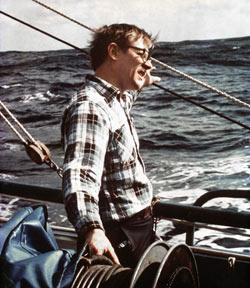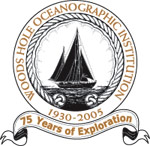This is an archived site. This site is no longer being maintained or reviewed for broken links.
Employee Portrait Gallery—Hartley Hoskins
 |
|
|
Hartley Hoskins checks the seismic streamer and magnetometer towlines during Knorr cruise 77 west of Bermuda in 1980.
|
While taking an MIT seminar in oceanography in spring 1958, Hartley Hoskins was one of seven students recruited by WHOI geophysicist Brackett Hersey to spend the following summer helping with a large sound transmission study. Part way through the summer, Bud Knott and Whitey Witzell tested their new 5,000 joule underwater sparker aboard R/V Bear—this was the first of 30 seismic-reflection profiling cruises for Hartley over the next 20 years. His contributions ranged from helping to build sound sources and hydrophone streamers to data analysis.
Along the way, Hartley completed a bachelor’s degree at MIT in 1959 and a Ph.D. at the University of Chicago in 1965. His thesis data, taken aboard WHOI ships, described the wedge of sediment that forms the continental rise off New England and the Mid-Atlantic states. (He recalls spending nine months in Woods Hole without support, except for the kindness of the Athearn family, to finish the thesis!) After a postdoctoral fellowship in Chicago and a summer of sonar surveying at Mediterranean archaeological sites with underwater photography pioneer Harold Edgerton of MIT, Hartley taught undergraduate geology at the University of Ghana for two years. Then he returned to WHOI’s Geology & Geophysics Department.
In 1977 he took on management of the Ocean Industry Program. Support from its petroleum industry members provided seed money for a number of WHOI projects and facilities, among them the Institution’s 1978 venture into word processing. Hartley and others, including Bob Groman and Mary Berry, accumulated two cartons of literature from 30 vendors and visited several Word Processing installations before recommending purchase of a Wang system. Hartley says the whole business nearly stalled until George Grice, then chair of the Biology Department, said he’d just returned from a meeting in Miami, where a word processor facilitated production of the meeting report over the lunch hour so he could make an afternoon plane. “If this system can do that,” George said, “let’s buy it.”
Since then, Hartley has maintained an abiding interest in telecommunications, including planning for, installing, and maintaining a microwave link that connected WHOI and MIT classrooms, telephones, and internet connections from 1983 to the mid-1990s. He has also been involved in setting up (and sometimes digging trenches for) other telephone systems, network wiring, and switch upgrades. As Network Group Leader for CIS, he is currently completing installation of a second fiber-optic cable linking the Quissett Campus and village properties to provide redundant, campus-wide communications. A next project will be to seek diverse pathways for continuous broadband communication off-Cape.
Between 1984 and 2001, Hartley operated Ralph Stephens’s borehole seismic instruments on seven Ocean Drilling Program cruises. “We would not have had a borehole seismology program on the drill ship without Hartley,” Ralph says. “He was continuously pro-active in recommending improvements to all aspects of the operation from scientific goals to instrumentation, engineering, and management.” Other of the versatile Hartley’s WHOI adventures include managing intellectual property for the Institution in the 1980s and serving as cook and seaman on the R/V Oceanus delivery cruise in 1975. Hartley’s devotion to the Institution was recognized in 1998 with the Vetlesen Award.
[back]

